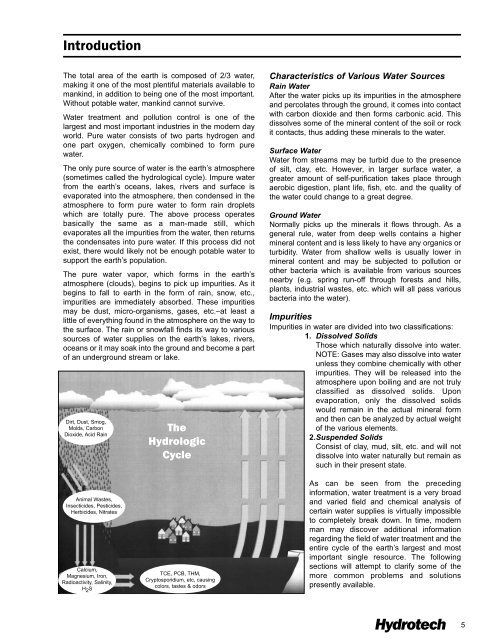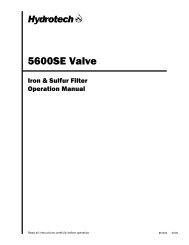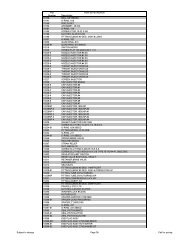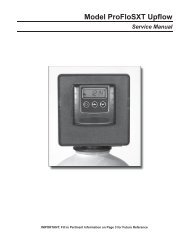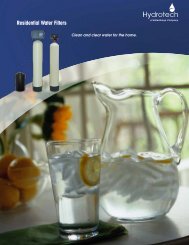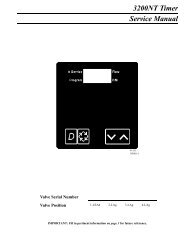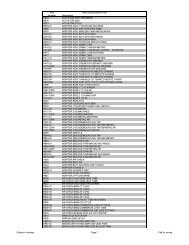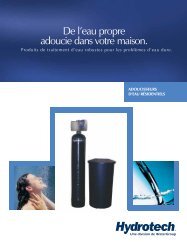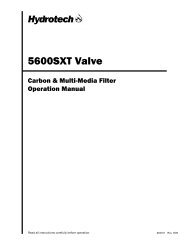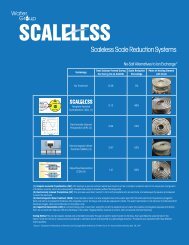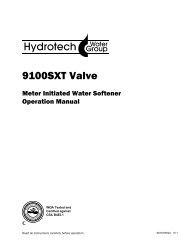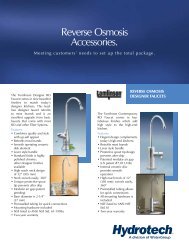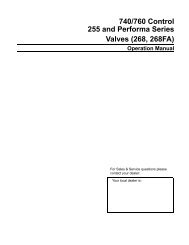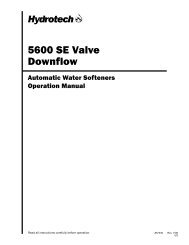HY US 01 Introduction.qxp - Hydrotech
HY US 01 Introduction.qxp - Hydrotech
HY US 01 Introduction.qxp - Hydrotech
You also want an ePaper? Increase the reach of your titles
YUMPU automatically turns print PDFs into web optimized ePapers that Google loves.
<strong>Introduction</strong><br />
The total area of the earth is composed of 2/3 water,<br />
making it one of the most plentiful materials available to<br />
mankind, in addition to being one of the most important.<br />
Without potable water, mankind cannot survive.<br />
Water treatment and pollution control is one of the<br />
largest and most important industries in the modern day<br />
world. Pure water consists of two parts hydrogen and<br />
one part oxygen, chemically combined to form pure<br />
water.<br />
The only pure source of water is the earth’s atmosphere<br />
(sometimes called the hydrological cycle). Impure water<br />
from the earth’s oceans, lakes, rivers and surface is<br />
evaporated into the atmosphere, then condensed in the<br />
atmosphere to form pure water to form rain droplets<br />
which are totally pure. The above process operates<br />
basically the same as a man-made still, which<br />
evaporates all the impurities from the water, then returns<br />
the condensates into pure water. If this process did not<br />
exist, there would likely not be enough potable water to<br />
support the earth’s population.<br />
The pure water vapor, which forms in the earth’s<br />
atmosphere (clouds), begins to pick up impurities. As it<br />
begins to fall to earth in the form of rain, snow, etc.,<br />
impurities are immediately absorbed. These impurities<br />
may be dust, micro-organisms, gases, etc.–at least a<br />
little of everything found in the atmosphere on the way to<br />
the surface. The rain or snowfall finds its way to various<br />
sources of water supplies on the earth’s lakes, rivers,<br />
oceans or it may soak into the ground and become a part<br />
of an underground stream or lake.<br />
Dirt, Dust, Smog,<br />
Molds, Carbon<br />
Dioxide, Acid Rain<br />
The<br />
Hydrologic<br />
Cycle<br />
Characteristics of Various Water Sources<br />
Rain Water<br />
After the water picks up its impurities in the atmosphere<br />
and percolates through the ground, it comes into contact<br />
with carbon dioxide and then forms carbonic acid. This<br />
dissolves some of the mineral content of the soil or rock<br />
it contacts, thus adding these minerals to the water.<br />
Surface Water<br />
Water from streams may be turbid due to the presence<br />
of silt, clay, etc. However, in larger surface water, a<br />
greater amount of self-purification takes place through<br />
aerobic digestion, plant life, fish, etc. and the quality of<br />
the water could change to a great degree.<br />
Ground Water<br />
Normally picks up the minerals it flows through. As a<br />
general rule, water from deep wells contains a higher<br />
mineral content and is less likely to have any organics or<br />
turbidity. Water from shallow wells is usually lower in<br />
mineral content and may be subjected to pollution or<br />
other bacteria which is available from various sources<br />
nearby (e.g. spring run-off through forests and hills,<br />
plants, industrial wastes, etc. which will all pass various<br />
bacteria into the water).<br />
Impurities<br />
Impurities in water are divided into two classifications:<br />
1. Dissolved Solids<br />
Those which naturally dissolve into water.<br />
NOTE: Gases may also dissolve into water<br />
unless they combine chemically with other<br />
impurities. They will be released into the<br />
atmosphere upon boiling and are not truly<br />
classified as dissolved solids. Upon<br />
evaporation, only the dissolved solids<br />
would remain in the actual mineral form<br />
and then can be analyzed by actual weight<br />
of the various elements.<br />
2.Suspended Solids<br />
Consist of clay, mud, silt, etc. and will not<br />
dissolve into water naturally but remain as<br />
such in their present state.<br />
Animal Wastes,<br />
Insecticides, Pesticides,<br />
Herbicides, Nitrates<br />
Calcium,<br />
Magnesium, Iron,<br />
Radioactivity, Salinity,<br />
H 2 S<br />
TCE, PCB, THM,<br />
Cryptosporidium, etc, causing<br />
colors, tastes & odors<br />
As can be seen from the preceding<br />
information, water treatment is a very broad<br />
and varied field and chemical analysis of<br />
certain water supplies is virtually impossible<br />
to completely break down. In time, modern<br />
man may discover additional information<br />
regarding the field of water treatment and the<br />
entire cycle of the earth’s largest and most<br />
important single resource. The following<br />
sections will attempt to clarify some of the<br />
more common problems and solutions<br />
presently available.<br />
<strong>Hydrotech</strong><br />
5


